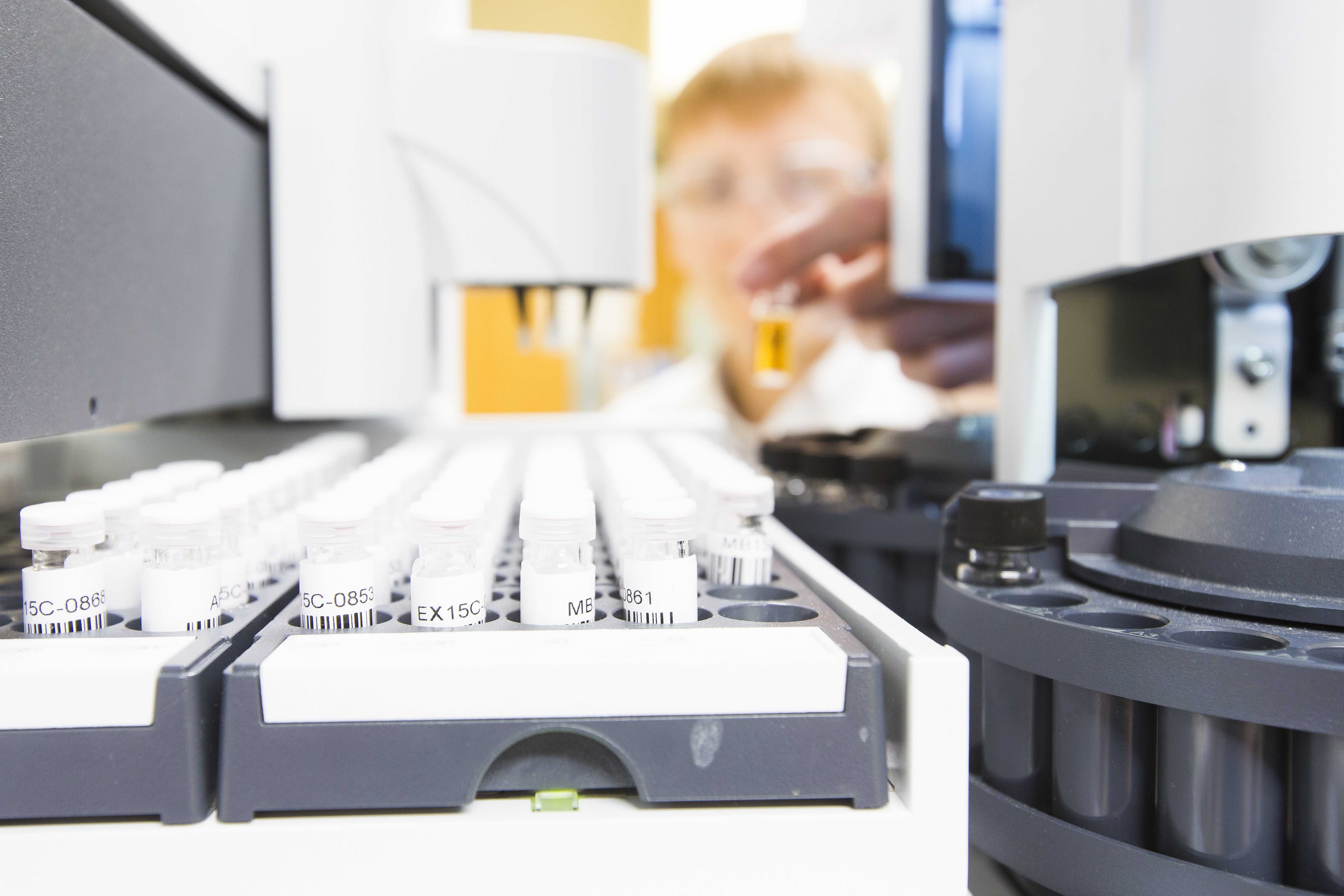Food Allergens
It is estimated that one in three of the total UK population (almost 20 million) will develop an allergy at some point in their lives (Royal College of Physicians June 03). Potential causes include food, insect bites, drugs and latex. A food allergy is an immune system response to a food that the body mistakenly believes is harmful. Once the immune system decides that a particular food is harmful, it creates specific antibodies to it.
The next time the individual eats that food, the immune system releases massive amounts of chemicals, including histamine, in order to protect the body. These chemicals trigger a cascade of allergic symptoms that can affect the respiratory system, gastrointestinal tract, skin, or cardiovascular system.
The most common causes (accounting for >90%) of food allergies are:
Peanut and nut, milk, eggs, seeds (such as sesame) fish, shellfish, soy and wheat.
Milk
|
Analytical Target |
UKAS Accredited |
Lower Limit of Quantification |
Upper Limit of Quantification |
LOQ units |
Sample Size |
|
| Quantitative Enzyme Linked Immuno-Sorbent Assay (ELISA) methods | ||||||
| MILK | ||||||
| Casein | Casein |
NO |
2.5ppm |
67.5ppm |
ppm Casein |
50g |
| b-lactoglobulin | b-lactoglobulin in whey proteins |
NO |
10ppb |
400ppb |
ppm b-lactoglobulin |
50g |
| Lactose | See HPLC methods | |||||
Nuts & Seeds
|
Analytical Target |
UKAS Accredited |
Lower Limit of Quantification |
Upper Limit of Quantification |
LOQ units |
Sample Size |
|
| Quantitative Enzyme Linked Immuno-Sorbent Assay (ELISA) methods | ||||||
| NUTS AND SEEDS | ||||||
| Almond | Almond protein |
YES |
2.5ppm |
20ppm |
ppm nut |
50g |
| Hazelnut | Hazelnut protein |
NO |
2.5ppm |
20ppm |
ppm nut |
50g |
| Macadamia | Macadamia protein |
NO |
1.0ppm |
27ppm |
ppm nut |
50g |
| Pistachio | Pistachio protein. Kit cross reacts with cashew |
NO |
1.0ppm |
25ppm |
ppm protein |
50g |
| Walnut | Walnut protein |
NO |
2ppm |
50ppm |
ppm nut |
50g |
| Cashew | Cashew protein |
NO |
2ppm |
50ppm |
ppm nut |
50g |
| Sesame | Sesame storage protein allergens |
NO |
0.5ppm |
5ppm |
ppm protein |
50g |
| Lupin | Lupin flour proteins |
NO |
1ppm |
27ppm |
ppm Lupin |
50g |
| Mustard |
White (yellow), black & brown mustard seed proteins Kit cross reacts with rapeseed |
NO |
1ppm |
10ppm |
ppm protein |
50g |
Please refer to the UKAS Schedule of Accreditation for the specific matrices.
Gluten, Egg & Soya
|
Analytical Target |
UKAS Accredited |
Lower Limit of Quantification |
Upper Limit of Quantification |
LOQ units |
Sample Size |
|
| Quantitative Enzyme Linked Immuno-Sorbent Assay (ELISA) methods | ||||||
| Gluten | R5 antibody / Mendez cocktail ELISA for quantitative analysis of prolamins from wheat (gliadins), rye (secalin)and barley (hordein) |
YES |
5ppm |
80ppm |
ppm gluten |
50g |
| Gluten: Recommended Approach for highly processed (hydrolysed) products e.g. Soya sauce | Competitive R5 antibody ELISA for quantitative analysis of peptide fragments of prolamins from wheat (gliadins), rye (secalin) and barley (hordein) |
NO |
5ppm |
135ppm |
ppm gliadin |
50g |
| Egg | Egg White protein |
YES |
0.5ppm |
10ppm |
ppm protein |
50g |
| Soya | Soya protein |
YES |
2.5ppm |
25ppm |
ppm protein |
50g |
Please refer to the UKAS Schedule of Accreditation for the specific matrices.
Low Level Lactose & Sulphur Dioxide
| Analytical Target |
UKAS Accredited |
Lower Limit of Quantification |
Upper Limit of Quantification |
LOQ units |
Sample Size |
|
| Low Level Lactose | Lactose is determined by ion-exchange chromatography with specific electrochemical detection. |
YES |
Limit Of Detection = 50ppm |
50g |
||
| Sulphur Dioxide / Sulphite | Sulphur dioxide is determined by a procedure based on the modified Monier-Williams method -distillation of SO2 into a hydrogen peroxide trapping solution. This is followed by highly specific determination of the sulphate produced using ion chromatography (i.e. NOT TITRATION which is less specific). |
YES |
Limit Of Detection = 2mg/Kg |
50g |
||
Please refer to the UKAS Schedule of Accreditation for the specific matrices.
Wheat DNA
|
Analytical Target |
UKAS Accredited |
Lower Limit of Quantification |
Upper Limit of Quantification |
LOQ units |
Sample Size |
|
| WHEAT | Wheat DNA detection utilising Polymerase Chain Reaction (PCR) Analysis |
NO |
Limit Of Detection = Approx 10ppm |
50g |
||
Nut Allergy – A Case Study
The Challenge
Our client had received reports that a consumer known to have a severe peanut allergy, had been hospitalised following an anaphylactic reaction. The food item implicated as the cause of the attack, was that of our client. Immediate testing was required to verify the presence or absence of peanut proteins in the food samples concerned.
The Solution
Samples were immediately delivered to Premier Analytical Services. In line with the customer’s immediate concerns a qualitative test for peanut protein was conducted. Some five hours later, when all samples but one tested negative for the presence of peanut proteins, additional samples relevant to the one which had already tested positive were submitted for further investigation using quantitative techniques.
The Result
The evidence provided by Premier Analytical Services enabled our client to identify the source of the peanut contamination. The supplier involved addressed the problem and is continuing to submit samples for testing to ensure products remain peanut free. On this occasion a product recall was not necessitated but labelling modifications were carried out.
The Secret
Premier Analytical Services has remained abreast of emerging tests and methodologies. We have been able to respond rapidly and professionally to the immediate needs of our clients by having the peanut protein detection kits set-up and fully validated.


To discover more on Anaphylaxis please click below.
Food Allergens
It is estimated that one in three of the total UK population (almost 20 million) will develop an allergy at some point in their lives (Royal College of Physicians June 03). Potential causes include food, insect bites, drugs and latex. A food allergy is an immune system response to a food that the body mistakenly believes is harmful. Once the immune system decides that a particular food is harmful, it creates specific antibodies to it.
The next time the individual eats that food, the immune system releases massive amounts of chemicals, including histamine, in order to protect the body. These chemicals trigger a cascade of allergic symptoms that can affect the respiratory system, gastrointestinal tract, skin, or cardiovascular system.
The most common causes (accounting for >90%) of food allergies are:
Peanut and nut, milk, eggs, seeds (such as sesame) fish, shellfish, soy and wheat.
Milk
|
Analytical Target |
UKAS Accredited |
Lower Limit of Quantification |
Upper Limit of Quantification |
LOQ units |
Sample Size |
|
| Quantitative Enzyme Linked Immuno-Sorbent Assay (ELISA) methods | ||||||
| MILK | ||||||
| Casein | Casein |
NO |
2.5ppm |
67.5ppm |
ppm Casein |
50g |
| b-lactoglobulin | b-lactoglobulin in whey proteins |
NO |
10ppb |
400ppb |
ppm b-lactoglobulin |
50g |
| Lactose | See HPLC methods | |||||
Nuts & Seeds
|
Analytical Target |
UKAS Accredited |
Lower Limit of Quantification |
Upper Limit of Quantification |
LOQ units |
Sample Size |
|
| Quantitative Enzyme Linked Immuno-Sorbent Assay (ELISA) methods | ||||||
| NUTS AND SEEDS | ||||||
| Almond | Almond protein |
YES |
2.5ppm |
20ppm |
ppm nut |
50g |
| Hazelnut | Hazelnut protein |
NO |
2.5ppm |
20ppm |
ppm nut |
50g |
| Macadamia | Macadamia protein |
NO |
1.0ppm |
27ppm |
ppm nut |
50g |
| Pistachio | Pistachio protein. Kit cross reacts with cashew |
NO |
1.0ppm |
25ppm |
ppm protein |
50g |
| Walnut | Walnut protein |
NO |
2ppm |
50ppm |
ppm nut |
50g |
| Cashew | Cashew protein |
NO |
2ppm |
50ppm |
ppm nut |
50g |
| Sesame | Sesame storage protein allergens |
NO |
0.5ppm |
5ppm |
ppm protein |
50g |
| Lupin | Lupin flour proteins |
NO |
1ppm |
27ppm |
ppm Lupin |
50g |
| Mustard |
White (yellow), black & brown mustard seed proteins Kit cross reacts with rapeseed |
NO |
1ppm |
10ppm |
ppm protein |
50g |
Please refer to the UKAS Schedule of Accreditation for the specific matrices.
Gluten, Egg & Soya
|
Analytical Target |
UKAS Accredited |
Lower Limit of Quantification |
Upper Limit of Quantification |
LOQ units |
Sample Size |
|
| Quantitative Enzyme Linked Immuno-Sorbent Assay (ELISA) methods | ||||||
| Gluten | R5 antibody / Mendez cocktail ELISA for quantitative analysis of prolamins from wheat (gliadins), rye (secalin)and barley (hordein) |
YES |
5ppm |
80ppm |
ppm gluten |
50g |
| Gluten: Recommended Approach for highly processed (hydrolysed) products e.g. Soya sauce | Competitive R5 antibody ELISA for quantitative analysis of peptide fragments of prolamins from wheat (gliadins), rye (secalin) and barley (hordein) |
NO |
5ppm |
135ppm |
ppm gliadin |
50g |
| Egg | Egg White protein |
YES |
0.5ppm |
10ppm |
ppm protein |
50g |
| Soya | Soya protein |
YES |
2.5ppm |
25ppm |
ppm protein |
50g |
Please refer to the UKAS Schedule of Accreditation for the specific matrices.
Low Level Lactose & Sulphur Dioxide
| Analytical Target |
UKAS Accredited |
Lower Limit of Quantification |
Upper Limit of Quantification |
LOQ units |
Sample Size |
|
| Low Level Lactose | Lactose is determined by ion-exchange chromatography with specific electrochemical detection. |
NO |
Limit Of Detection = 50ppm |
50g |
||
| Sulphur Dioxide / Sulphite | Sulphur dioxide is determined by a procedure based on the modified Monier-Williams method -distillation of SO2 into a hydrogen peroxide trapping solution. This is followed by highly specific determination of the sulphate produced using ion chromatography (i.e. NOT TITRATION which is less specific). |
YES |
Limit Of Detection = 2mg/Kg |
50g |
||
Please refer to the UKAS Schedule of Accreditation for the specific matrices.
Wheat DNA
|
Analytical Target |
UKAS Accredited |
Lower Limit of Quantification |
Upper Limit of Quantification |
LOQ units |
Sample Size |
|
| WHEAT | Wheat DNA detection utilising Polymerase Chain Reaction (PCR) Analysis |
NO |
Limit Of Detection = Approx 10ppm |
50g |
||
Nut Allergy – A Case Study
The Challenge
Our client had received reports that a consumer known to have a severe peanut allergy, had been hospitalised following an anaphylactic reaction. The food item implicated as the cause of the attack, was that of our client. Immediate testing was required to verify the presence or absence of peanut proteins in the food samples concerned.
The Solution
Samples were immediately delivered to Premier Analytical Services. In line with the customer’s immediate concerns a qualitative test for peanut protein was conducted. Some five hours later, when all samples but one tested negative for the presence of peanut proteins, additional samples relevant to the one which had already tested positive were submitted for further investigation using quantitative techniques.
The Result
The evidence provided by Premier Analytical Services enabled our client to identify the source of the peanut contamination. The supplier involved addressed the problem and is continuing to submit samples for testing to ensure products remain peanut free. On this occasion a product recall was not necessitated but labelling modifications were carried out.
The Secret
Premier Analytical Services has remained abreast of emerging tests and methodologies. We have been able to respond rapidly and professionally to the immediate needs of our clients by having the peanut protein detection kits set-up and fully validated.


To discover more on Anaphylaxis please click below.
